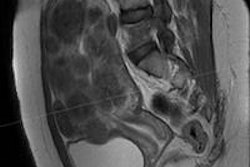Women who received one of three treatments for uterine fibroids at Brigham and Women's Hospital said their symptoms diminished and their quality of life significantly increased, according to a new study published online today in Radiology.
In addition, patients preferred less invasive procedures such as MR-guided focused ultrasound (MRgFUS) or uterine artery embolization (UAE).
Dr. Fiona Fennessy, PhD, assistant professor of radiology at Harvard Medical School, and colleagues surveyed 197 women who underwent either hysterectomy, UAE, or MRgFUS for symptomatic uterine fibroids between 2004 and 2006. Sixty-two of the women had a hysterectomy, 74 received UAE, and 61 received MRgFUS (Radiology, March 1, 2011).
The mean age of women who underwent MRgFUS was 47 years; for women who underwent UAE, the mean age was 44 years, and for women who underwent hysterectomy, the mean age was 48 years. The time between the procedure and the survey was greater for women who underwent MRgFUS, compared to those who underwent UAE or hysterectomy, at four years versus two years, respectively.
Fennessy's team found a utility weight -- a single unit of measure that encompasses all the different quality-of-life benefits from a healthcare intervention -- for each of the fibroid treatment options, allowing comparisons of quality of life before and after treatment. The team also compared short-term utility weights for the actual treatments the women underwent, using the waiting trade-off (WTO) method, which is based on the fact that people tend to wait longer to avoid unpleasant tests or procedures, Fennessy and colleagues wrote.
Quality of life increased with all fibroid treatments, but patients rated the less invasive treatments, MRgFUS and UAE, more favorably, the group found. In fact, women who were to undergo these procedures said they would wait less time: 14 weeks, compared to 21 weeks for hysterectomy.
"Wait times indicated that patients who underwent hysterectomy judged that experience to be significantly worse than did those who underwent UAE and MR image-guided focused ultrasound surgery," the authors wrote.
The choice of fibroid treatment depends on symptoms, location, burden, cost, patient preference, and quality-of-life implications, they wrote. And when expressed in terms of dollars per quality-adjusted life-years, cost-utility analysis defines the best treatment option as that which gains the most quality-adjusted life-years with the least cost.
The study offers important data for future cost-effectiveness evaluations of uterine fibroid treatments, and the results will help radiology departments better decide which treatments to offer their patient populations, Fennessy told AuntMinnie.com.
"In order to be widely adopted, MRgFUS must be deemed as beneficial as the established alternatives," she said. "Our study not only provides measures that aid in more exact and robust cost-utility analysis of uterine fibroid treatments, but it may be helpful to patient and physician decision-making with regard to treatment options."




.fFmgij6Hin.png?auto=compress%2Cformat&fit=crop&h=100&q=70&w=100)



.fFmgij6Hin.png?auto=compress%2Cformat&fit=crop&h=167&q=70&w=250)











